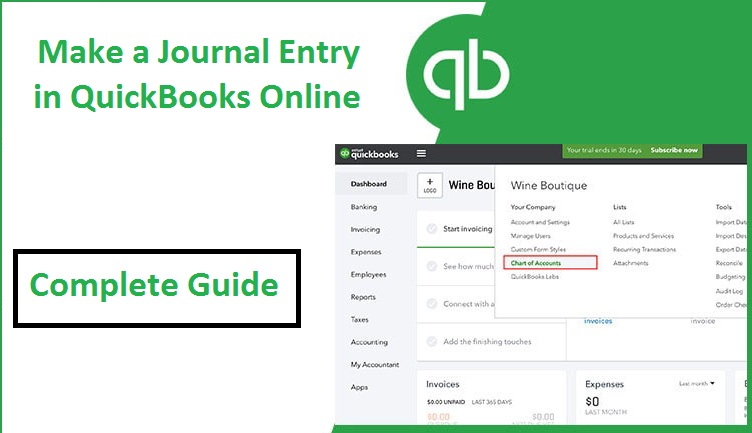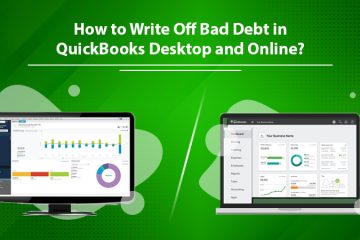How to Make a Journal Entry in QuickBooks Online?

Every business owner needs to manage the resources that he/she is using to run the business. There is a need for robust record-keeping to keep a strong eye on where the resources are coming from and for what purpose they are being used. That’s where you can make a journal entry in QuickBooks online to record the business transaction. It can help you in several ways, such as editing an accounting error, tracking the credit or debit, and monitoring where the business money is spent.
Though QuickBooks automatically records the transactions and puts them in the general ledger, still, you can manually edit the transactions whenever you need, through the journal entry feature. With QB accounting software, you can record invoices, generate sales receipts, prepare bills, checks, etc. Further, they can be placed into a general ledger. How to avail of these classic features? As you go down the article, you will learn all the steps to make a journal entry online in QuickBooks software. Here we go.

Journal entry – What’s that?
The QuickBooks users often remain confused about making a journal entry in QuickBooks online and end up outsourcing their accounting tasks. Having the necessary know-how of the journal ledger is essential to run the business smoothly. It is basically segregated into two parts – credit and debit; as a thumb rule, the sum of both should tally. The general ledger acts as the main group of accounts in a company to record the balance sheet of income and expenses. The journal entry consists of a few essential components. Here are they.
- The transaction date.
- The impacted account name along with account number.
- The amount that needs to be credited or debited.
- Transaction reference number.
- Transaction description.
Why to use the journal entry in QuickBooks online?
Various benefits of journal entries tempt you to use them. Following are some of the most vital reasons.
- You can use it while sending money between income and expense accounts.
- You can also use journal entry in QuickBooks online while transferring money from liability, asset,or equity account to the income and the expense accounts.
- Additionally, you may use the journal entry to enter the debit and credit in the general ledger.
What to ensure while making journal entries?
There are a few things that you will need to ensure while making journal entries, such as.
- The first thing that needs to be taken care of is journal entries should not be made to inventory or payroll accounts.
- For every entry, there should be one account receivable or one account payable.
- Also, there should be an entry of customer or vendor for every payable or receivable type account.
- If a user wants to rectify any transaction, they will have to do it by deleting and reversingthe journal
- An important thing to note is, QuickBooks does not support multi-currency in a single journal entry. Hence, every currency has its journalentry.
- While making journal entries in QB online plus, the user isrequired to view the additional columns for the location and class.
Steps to make a journal entry in QuickBooks
Here are the steps to create a QuickBooks journal entry. Follow them in a given order to avoid any issue.
Step 1: Go to the journal entry feature
The first step towards creating a journal entry in QuickBooks is.
- Go to the journal entry feature.
- Click the plus icon on the top-right side of the file.
- A drop-down list will open with the heading Create; here you will need to click journal entry.
- After that,you will be directed to a new window wherein you will need to fill in the desired information.
Step 2: Provide the date and journal number
After navigating to the journal entry feature, you will have to provide the date and journal number in a form that you have opened in the previous step. For that, once the document opens on your computer screen, edit the journal date, and ensure that the current date is updated automatically in QuickBooks. If you are entering data from a past date or month, ensure that it is updated on QuickBooks before moving further. Once the entry date is rectified, then you will need to enter the journal number. QuickBooks automatically enters the sequential number if you do not put in the journal number manually. For example, if the journal number is 101, then QuickBooks will automatically and sequentially follow this number that is 102.
Step 3: Fill in the desired information
The following are categories that you will need to fill to proceed with journal entries.
- Accounts or chart of accounts – Here, you should enter the necessary account details.
- Journal code – After the chart of accounts, you should enter the journal code linked with the account. Make sure you use the same journal code that is related to debit and credit account transactions.
- Debit or credit– You can look for transactions in recent transaction reports. Here the first in line is debit, and you can also verify if the debit has changed once the transaction is made.
- Description– You can enter the description details for every transaction.
- Enter name– Here, you can choose the customer, employee, or vendor name. Make sure to enter the correct details.
Step 4: Select the recurring journal entry schedule
It would help if you chose the recurring journal entry schedule In case a specific transaction happens in a regular interval. You can select the template name (transaction name), interval (set date and month), and choose the start date. Once you save the transaction, click finish.
You may also like: QuickBooks Conversion Tool
Ending note
Hopefully, these four steps have made it clear how you can create a journal entry in QuickBooks online. Though QuickBooks executes many functions in the background, you must manually know the technicalities of doing journal entries. It will assist you in rectifying any mistake or entering the transactions manually, just in case. If you want any further clarification, you must contact the certified QuickBooks experts.


